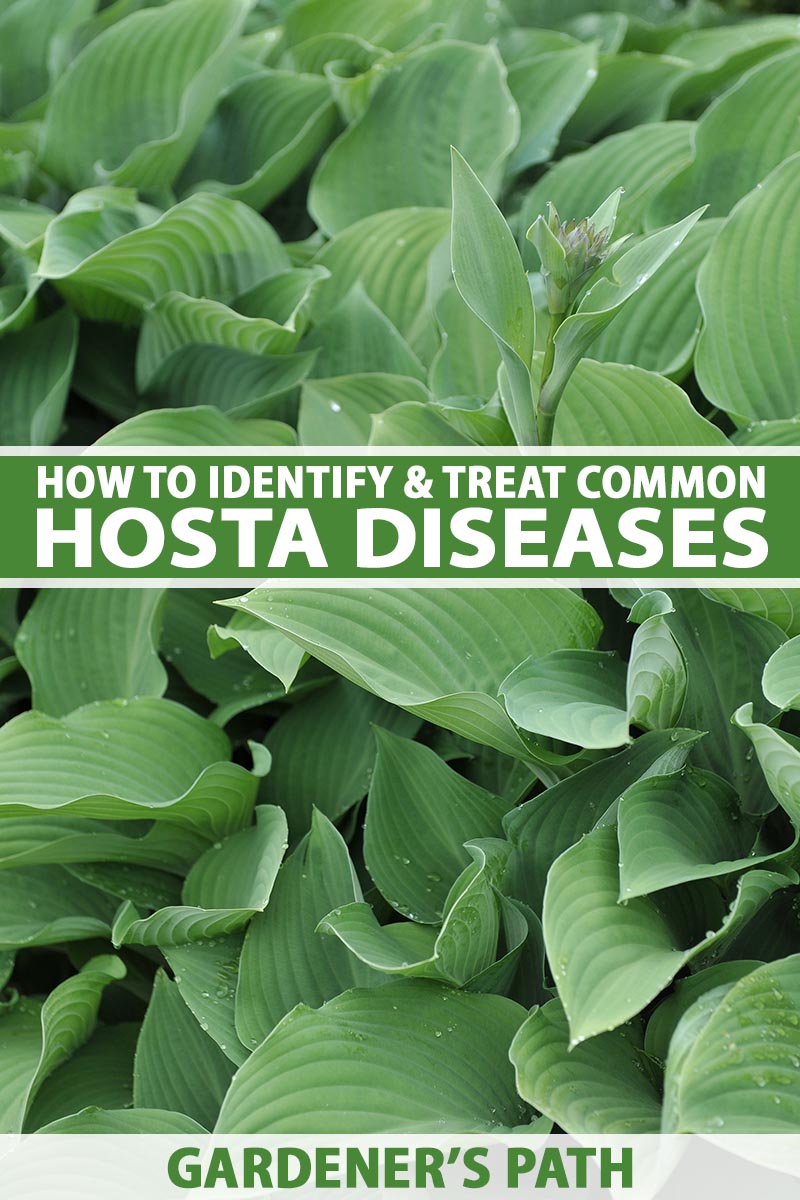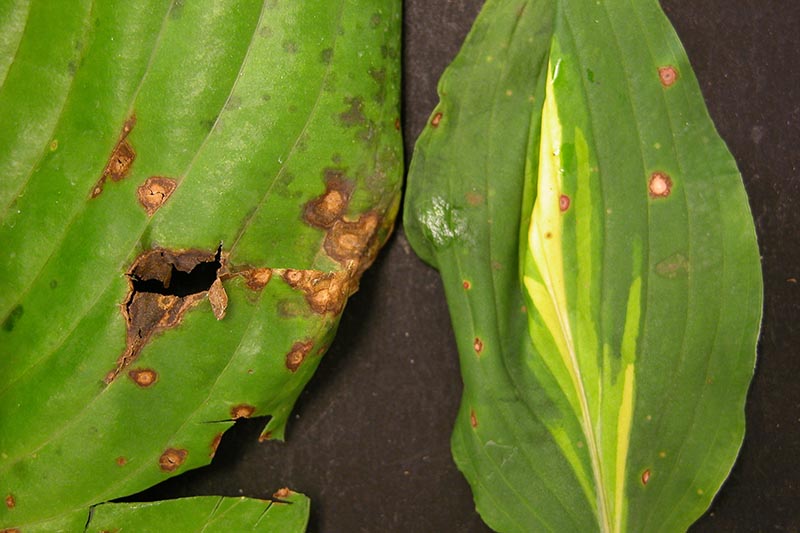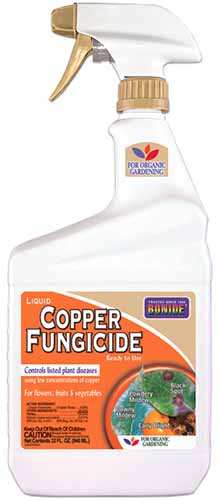They’re also low maintenance and extremely resistant to disease (we won’t talk about slugs, however). So when your hosta looks like someone beat it up with a baseball bat, it can be extra distressing. We link to vendors to help you find relevant products. If you buy from one of our links, we may earn a commission. If you can relate, don’t feel bad. Just because hostas are typically disease-resistant, that doesn’t mean they’ll only get sick if you mess up. Sometimes stuff happens. This guide will help you figure out what to do if you find your plants looking miserable. Here are the diseases that we’ll cover: Hostas go dormant in the heat, which leaves them susceptible to diseases. The same goes for those that are stressed by sun scorch or drought. In other words, do your best to plant your hostas in a spot where they will be protected from too much sun, protect them during extreme heat, and make sure they always have the water they need. Also, be aware that sometimes what looks like a disease is actually a pest problem. Voles can chomp on the roots leaving them looking sad aboveground with no obvious cause. Examine your plant and compare your symptoms to those listed below to be sure you know what you’re dealing with.
1. Anthracnose
If you’re going to run into disease problems when growing hostas, this is the one you’ll most likely see. It’s pretty widespread and it’s caused by numerous different fungi (all in the Colletotrichum genus) that exist across the planet. The good news is that this probably won’t kill your plants, but it can be pretty ugly. If you know that anthracnose is in your area or you’ve struggled with it in past years, treat your plants with copper as described above as soon as the leaves unfurl and before you see any symptoms. While many pests, diseases, and environmental issues can cause small circular spots to form, only anthracnose has a dark, nearly black border around the irregular spot. The inside of the hole may fall out eventually, which is another indicator. Dealing with this disease takes a multi-step approach. The first step is to trim away all of the infected leaves. Next, treat the remaining leaves with copper fungicide. I like Bonide’s copper fungicide, which is available at Arbico Organics in 16 or 32-ounce ready to spray, 32-ounce ready to use, or 16-ounce concentrate. Bonide Copper Fungicide Repeat every week for at least a month. Finally, make absolutely sure you’re only watering at the soil level rather than on the leaves, and water in the morning so the leaves have time to dry. This makes it much more difficult for the fungus to spread in the future, because moisture helps it spread.
2. Bacterial Soft Rot
Bacterial soft rot impacts the stems (technically called petioles) and the lowest leaves on the plant. These will turn soft and mushy. If you kneel down and take a big whiff, you’ll notice a rotten smell. The bacteria that cause this problem (species in the Erwinia genus) often enter through cuts, freeze damage, or insect damage on the stems and leaves. Poor drainage, high humidity, and temps over 80°F increase the chances that this disease will attack. Unfortunately, there is no treatment, so you’ll have to pull the plants and start over.
3. Cercospora Leaf Spot
Unlike spots caused by anthracnose, which have a black border, those caused by Cercospora have a rust-colored border with a tan or red center. Similar to anthracnose, this probably won’t kill your plant but it will mar the appearance. This is common in the US south and appears during the hottest part of the summer. The treatment is identical to anthracnose, so don’t worry if you can’t tell the two apart.
4. Fusarium Rot
If your hosta leaves turn yellow and then brown before withering away, fusarium root and crown rot might be paying your plants a visit. Stunting (both above and below ground) is also common. Many species in the Fusarium genus cause the disease, but F. hostae is the most common. Unfortunately, once this disease is in your soil, it’s there for a long, long time. So long that you might as well forget ever planting hostas in that same spot again. The fungus that causes this disease (Sclerotinium rolfsii var. delphinii) thrives when air temps reach 80 to 90°F and there’s lots of rain or humidity. Avoiding it involves practicing good sanitation. Clean your tools before using them in the garden and use a pre-planting dip anytime you divide your mature plants or plant new seedlings. Then, soak the soil again a day after planting. Pre-planting dips contain chemicals such as hydrogen dioxide to kill off harmful pathogens. TerraClean 5.0 For instance, TerraClean 5.0, available at Arbico Organics in five-gallon containers, contains hydrogen dioxide and peroxyacetic acid.
5. Petiole Rot
You don’t want this disease, sometimes known as sclerotinia or crown rot. It kills quickly and is extremely hard to get rid of because it can survive through drought and freezing weather. It can also spread on plant debris, soil, your shoes, or garden tools. It starts as a sort of white slime on the petioles. This fungal growth eventually turns tan or reddish-brown. The leaves turn yellow, then brown, then they turn mushy and die. Leaves pull away from the stems easily and eventually the entire plant collapses. This disease has spread across the US on contaminated nursery plants, so always inspect new specimens before planting them. ‘Halcyon,’ ‘Honeybells,’ ‘Snow Mountain,’ and ‘Tall Twister’ are resistant to this disease. Avoid planting ‘Lemon Lime,’ ‘Munchkin,’ ‘Nakaiana,’ ‘Platinum Tiara,’ and ‘Tardiflora.’ Unfortunately, there isn’t any effective treatment for the home gardener. You’ll need to pull the plants and then dig down at least six inches and remove the soil. Replace it with fresh, clean soil.
6. Phytophthora Foliage Blight
While it’s not as common as some of the other diseases on this list, phytophthora foliage blight is becoming a bigger problem. This disease thrives in wet soil. If phytophthora strikes, you’ll notice water-soaked spots on the leaf that start to spread and become larger. Eventually, the center of the spot will turn brown and dry. Underground, the roots will be unhealthy and start to rot away. The entire plant will grow slowly and be stunted before eventually dying. The best way to deal with this disease is to avoid it in the first place. If only we could do that with all diseases, right? To avoid it, check plants when you buy them for any signs of disease. Don’t bring them home if they have any evidence of disease. Once you plant, be sure to water at the soil level and be careful not to overwater. Soggy soil is a quick route to disease. Remove and destroy any plants that exhibit signs phytophthora foliage blight.
7. Viruses
There are a few different viruses that can attack hostas, including hosta virus x (HVX), tomato ringspot virus (ToRSV), impatiens necrotic spot virus (INSV), and tobacco rattle virus (TRV). All of the viruses cause brown and yellow spots and discoloration. INSV results in green and yellow bullseyes, ToRSV causes yellow and green spots with faded margins, and HVX can be identified by the angular yellow and light green splotches. None of these can be treated, so avoidance is your only option. All of these spread easily on tools, plant material, clothing, and weeds. Practicing good garden hygiene is paramount, as is controlling thrips, which can spread some viruses. While there are many diseases that can impact those perennial shade favorites, they rarely do. Stressed plants are more likely to be infected than healthy ones, and good garden hygiene like cleaning your tools regularly can help limit trouble. What troubles are you facing? What worked for resolving the situation? Let us know in the comments so we can share any helpful info! Did this guide play a role in helping you figure things out? If so, you might find some of our other hosta guides useful in making your plants really thrive. Check out the following:
How to Grow Hostas: A Favorite Shade Loving PerennialHow to Grow Hostas in ContainersKeep or Cut: How to Make the Most of Hosta Flowers






